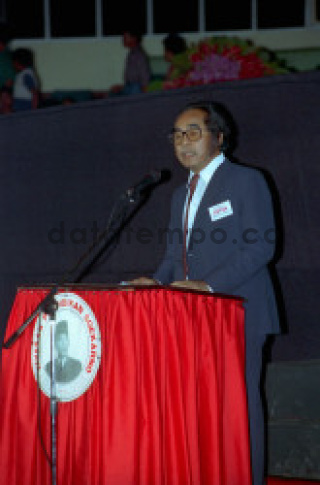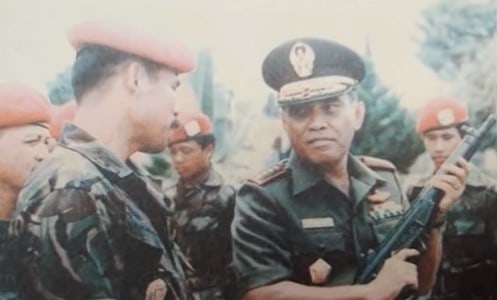22.7. The Great Urbanization: ABRI
Angkatan Bersenjata Republik Indonesia
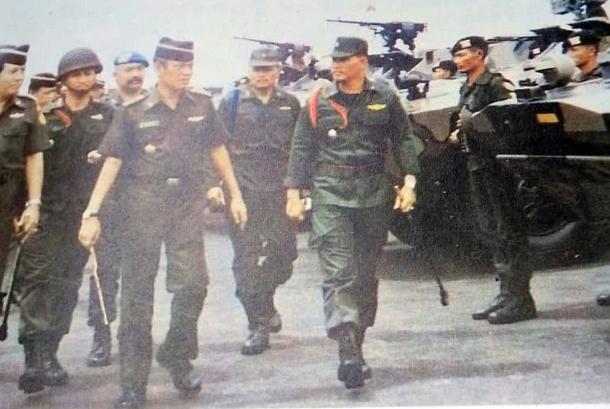
General Try Sutrisno during a military parade, 1987

General Try Sutrisno during a military parade, 1987
The Armed Forces of Indonesia has its roots as well as the rebellious forces against colonial tyranny. Birthed during the Indonesian Revolution, the armed force’s doctrine involved cooperating with the masses to ensure a cohesive defence capability without superior firepower. This principle evolved under a single abbreviation of Sishankamrata or Sistem Pertahanan dan Keamanan Rakyat Semesta.
The foundation for Sihankamrata came from the 1945 Constitution of Indonesia Article 30 Clause 1, which states that ‘every citizen has the right and obligation to defend the country’. This article evolved under the RIS Constitution in 1949, and then the 1964 Constitution as Article 32, before being re-edited as Article 35 of the 1973 Indonesian Constitution. Under the core Constitution, derived regulations expand the term on the methods, structure, and organization of the national defence. Still, national defense is not impenetrable to political debate, and even personal vendetta against military leaders. The first organization of the Indonesian Armed Forces is Badan Keamanan Rakyat (BKR). However, on the 5th of October 1945, the armed forces restructured as Tentara Keamanan Rakyat (TKR). This change was not enduring, because the early revolutionary government eventually changed names into Tentara Nasional Indonesia (TNI), which will eventually become the modern name of Indonesia’s Armed Forces.
During the Indonesian Revolution (1945-1949), TNI succeeded in becoming the people’s revolutionary army marked by its successes in major operations, most notably the General Offensive of 1 March 1949. During the interwar period of 1950-1956, the Indonesian government had few rebellions, separatism, and general restructuring of the newly formed government, before eventually succumbing to another deadly Australian Aggression. It was only until the year 1966, after the final shots of the Aggression had been completed, that the TNI finally had a relatively peaceful period to restructure and redirect their defence focus. Nevertheless, the relative peace hasn’t stopped the TNI from being deployed abroad, especially during the short period of interventionism in Mozambique and Angola.
Power Evolution
In its infant years, TNI’s power was within the Army. Holding the most personnel in the armed forces, the Army defended Indonesia in its infant years, especially acclaimed in the early revolutionary years of Indonesia. Marked with the guerilla doctrine in both the Dutch and Australian Aggression, Indonesia’s Army became the backbone of defence of those islands. With the Army’s closeness to the local population, the Army remained a strong political force in Indonesian politics, an obvious example being the rapid rise of Parindra, which later influenced the PNI to become the modern PNI-R and PRD.
However, after the end of the Australian Aggression, the sacrifices of both the Navy and the Air Force during the bombardment years of the war reinforced Nasution’s direction for a stronger Navy and Air Force. After the settlement of peace, Nasution’s Revolusi Biru policy adopted a significant increase in Navy and Air Force funds, while the Army owned its financial balance within its staff. Although Nasution’s administration has minimal focus on the expansion of the Army, Nasution established the permanent creation of Komando Cadangan Strategis Angkatan Darat (Kostrad) and Komandan Pasukan Khusus (Kopassus), both commands have involved themselves in notable military operations, such as the Kismayo Crisis and Interventions in the Mozambique and Angola in several offences.
The foundation for Sihankamrata came from the 1945 Constitution of Indonesia Article 30 Clause 1, which states that ‘every citizen has the right and obligation to defend the country’. This article evolved under the RIS Constitution in 1949, and then the 1964 Constitution as Article 32, before being re-edited as Article 35 of the 1973 Indonesian Constitution. Under the core Constitution, derived regulations expand the term on the methods, structure, and organization of the national defence. Still, national defense is not impenetrable to political debate, and even personal vendetta against military leaders. The first organization of the Indonesian Armed Forces is Badan Keamanan Rakyat (BKR). However, on the 5th of October 1945, the armed forces restructured as Tentara Keamanan Rakyat (TKR). This change was not enduring, because the early revolutionary government eventually changed names into Tentara Nasional Indonesia (TNI), which will eventually become the modern name of Indonesia’s Armed Forces.
During the Indonesian Revolution (1945-1949), TNI succeeded in becoming the people’s revolutionary army marked by its successes in major operations, most notably the General Offensive of 1 March 1949. During the interwar period of 1950-1956, the Indonesian government had few rebellions, separatism, and general restructuring of the newly formed government, before eventually succumbing to another deadly Australian Aggression. It was only until the year 1966, after the final shots of the Aggression had been completed, that the TNI finally had a relatively peaceful period to restructure and redirect their defence focus. Nevertheless, the relative peace hasn’t stopped the TNI from being deployed abroad, especially during the short period of interventionism in Mozambique and Angola.
Power Evolution
In its infant years, TNI’s power was within the Army. Holding the most personnel in the armed forces, the Army defended Indonesia in its infant years, especially acclaimed in the early revolutionary years of Indonesia. Marked with the guerilla doctrine in both the Dutch and Australian Aggression, Indonesia’s Army became the backbone of defence of those islands. With the Army’s closeness to the local population, the Army remained a strong political force in Indonesian politics, an obvious example being the rapid rise of Parindra, which later influenced the PNI to become the modern PNI-R and PRD.
However, after the end of the Australian Aggression, the sacrifices of both the Navy and the Air Force during the bombardment years of the war reinforced Nasution’s direction for a stronger Navy and Air Force. After the settlement of peace, Nasution’s Revolusi Biru policy adopted a significant increase in Navy and Air Force funds, while the Army owned its financial balance within its staff. Although Nasution’s administration has minimal focus on the expansion of the Army, Nasution established the permanent creation of Komando Cadangan Strategis Angkatan Darat (Kostrad) and Komandan Pasukan Khusus (Kopassus), both commands have involved themselves in notable military operations, such as the Kismayo Crisis and Interventions in the Mozambique and Angola in several offences.
Indonesian adventurism in the Mozambique, 1984
Although it seems the government focuses on the Air Force, the Navy (and eventually the Coast Guard), the Army maintained dominance because of its resilience to the national budget, which was well campaigned in local politics. The Army Generals, instead of accusing the Nasution government of undermining the strength of the Army, used this policy for their political benefit. Their highly efficient spending (learned from the disordered organization during both Dutch and Australian Aggression) has improved the Army’s capabilities even with limited government funding. These Generals negotiated with the Nasution government, to trade business rights for lesser funds. After General Suharto’s lucrative business in Papua, more Army Generals stepped in to enjoy the profits. However, the dominance of the Army is slowly waning, not because of the Army’s importance in the Indonesian government, but of the Army’s slow decadence in defending the nation and owning a business interest that might contradict the government’s focus. The Labour Crisis of 1986 shows that the Army Generals intended to not conform with the government’s decision not rising since increasing the minimum wage in Nusantara has helped Papua and Madagaskar as business havens.
The focus of the Army in more areas rather than defence, shifted the defence capabilities of the Indonesian government to entrust the Air Force, the Navy, and the Coast Guard. The Navy has been the largest of the three branches of the Armed Forces, purchasing any ships and marine power affordable enough as directed by the Federal government. However, that hasn’t stopped the Air Forces, the most expensive of the branches, from developing a significant defence in aerial warfare. Indonesia’s warm relationship with the United States has given the Air Force decent aerial improvements, such as new fighters, better technologies, and aerial warfare training. The Coast Guard, established under Nasution’s concerns of piracy, was expanded under the Subandrio Administration for its strategic role in Indonesian maritime trade. Although the bureaucrats have mentioned the redundant role of the Coast Guard (from the existence of the Navy), Nasution and Subandrio have stated that the Coast Guard is necessary for its branch for Indonesia’s vast maritime territories, which is extremely prone to maritime law violations. From this principle, the Coast Guard is slowly gaining more personnel, popularity, and power as the role has become “the Sea Police”.
The Army (Angkatan Darat Republik Indonesia)

The modern Army, after a series of expansions of the organization, has its main purpose of reinforcing land defence in the Federal Republic of Indonesia. The main operational commands of the Army are Kostrad, Kopassus and Kodam (Komando Daerah Militer). There are also nonoperational commands of the Army consisting of Akmi (Akademi MIliter), Secapaad (Sekolah Calon Perwira Angkatan Darat), Seskoad (Sekolah Staf dan Komando Angkatan Darat) and Kodiklatad (Komando Pembina Doktrin, Pendidikan dan Latihan Angkatan Darat).
The Army, for its land capabilities, has decreased its operation after the end of the Australian Aggression. This active operation in Indonesia has been either border patrol on the Thailand-Indonesian border, or the insurgency risks caused by the ongoing intelligence of active separatism movements (most notably Gerakan Aceh Merdeka, Organisasi Papua Merdeka and Fretilin). However, the Army’s largest achievement was the formation of Ikatan Bisnis Angkatan Darat Indonesia (IBADI), an influential business group that is partly responsible for the high economic growth of Indonesia. The Army’s popularity came from both Kostrad and Kopassus, as both have a significant presence in local livelihood, especially the infrastructure programs of Nasution, the interventions of Subandrio, and the IBADI’s strength in several regions of Indonesia.
Indonesia’s Army has its main products mostly from the US and Germany, although major of the equipment is from the Comecon nations. As Indonesia’s trade with Germany remained relatively great, the German government gave their most advanced main battle tank, Leopard 2, into Indonesian inventory, to which the Americans (hearing the news) responded the gift by granting dozens of Sherridan-class tanks to Indonesia. On the other spectrum, Indonesia has newly received BTR-70 from the Soviet Union along with S-75 and BM-21 (which was refit as Pindad R-Han 21), which was part of Subandrio’s defence purchase. However, many of the smaller purchases, such as firearms, rocket salvos and rifles, have been gradually shifting to Indonesian-made products since 1980.
Leopard 2 in training, 1986
Army politics have been the murkiest, because of the division between army generals. Under modern circumstances, the Army has been divided into three equal factions, the Nusantara Faction, IBADI Faction, and the Green Faction. The Nusantara Faction is the purist faction which intends to restore the Army’s sole purpose to defend the nation, not as political and economic players from the IBADI Faction. Led by current General Alex Evert Kawilarang, Marshall Yosaphat Soedarso, General Benny Moerdani and Colonel Hendropriyono. Other factions have called the Nusantara Faction the Blue Faction because most members have come from the Air Force and the Navy [such as Lieutenant Colonel Susilo Bambang Yudhoyono], although there are some prominent members in Kostrad and Kopassus such as General Wismoyo Arisumunandar and Colonel Agum Gumelar. The IBADI Faction consists of the PRD-clique that revolves around Suharto-ism, those being retired General Untung, retired General Umar Wirahadikusumah, retired General Try Sutrisno and Lieutenant General Edi Sudradjat. The faction is mostly the highest staff of the Army, with less penetration to lower personnel from the IBADI’s faction exclusivity on generals that participate in the liberation of Papua. However, that might change considering the IBADI Faction attracts young officials to “follow their seniors”. The Green Faction is a new wing from the religious-sympathetic army personnel, which was expanded to involve pro-Kesejahteraan Rakyat policies that adopt a more modernist approach against social and economic issues of Indonesia pioneered by Mahathir Mohammad. General Susilo Sudarman, Lieutenant General Raden Hartono and General Mohd Ghazali have been under increasing influence especially since Susilo Sudarman won the election in 1988.
The Navy (Angkatan Laut Republik Indonesia)

The modern Navy has its main purpose of performing military duties to enforce national jurisdiction against foreign violations, perform diplomatic duties in support of foreign policies, and support defence capabilities in sea defence areas assisted by the Coast Guard. The main operation of the Navy is the Koarmada (Komando Armada), Kodiklatal (Komando Pembina Doktrin, Pendidikan dan Latihan Angkatan Darat), Korps Marinir, and Kolanal (Komando Pangkalan Angkatan Laut).
Special for the Navy, the Koarmada is a specific armada command which designates a specific area of responsibility under a single fleet. This command, approved by the Nasution Administration, is divided into 4 commands, those being Armada Command I (for the Western portion of Nusantara State Republic, Armada Command II (for the Eastern portion of Nusantara State Republic), Armada Command III (for Papua State Republic and portions of Maluku), and finally the Armada Command IV (for the Indian Ocean Territories, such as Madagaskar and Chagas Archipelago). Each of the Armada consists of a formidable fleet, with the largest of it currently in Armada Command I, although Armada Command IV has been increasing in size.
Although the Navy has less quantifiable mentions in comparison to the Army, many of their victories marked significant tide changes in war, especially in Australian Aggression. For the nation’s maritime vastness in territory, Indonesia’s Navy has also been increased, both in capabilities and technologies, to accommodate the increasing demands of security in trade, fishing industry and territorial sovereignty. Their one-sided attacks against Britain around the 1960s, which sometimes blocked invasions to Java Island, have marked adequate mentions to the Indonesian public, as well as a definite reminder to improve the naval force of the nation.
Different from the Army which has a rather pragmatic purchase, the Navy has purchased almost entirely from the United States, except the submarines. The Farragut Class and the Leahy Class have been Indonesia’s top purchases, with the Oliver Hazar Perry frigate class as Indonesia’s screen frigates. In submarine warfare, the Tango class was often purchased from the Soviet Union, although the Germans also created the Cakra class.
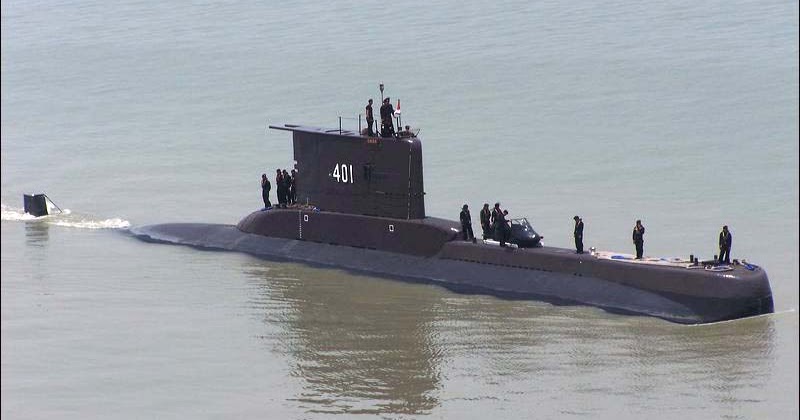
Cakra Class, 1986
Since politics were nearly unappealing in the Navy (even though a slight PKI scare in the 1960s), the Navy remained a professional force in the Armed Forces, avoiding the muddy politics already done by the Army. Still, for its insistence on meritocratic ideals, the Navy has become a supporter of the Nusantara Faction, which its created only to oppose the growing IBADI Faction and Green Faction of the Armed Forces. Nevertheless, should the Navy pick a stand, it is certainly within the Nusantara Faction.
The Air Force (Angkatan Udara Republik Indonesia)
The modern Air Force's main purpose is to perform military duties to enforce the aerial sovereignty of the Indonesian Republic. The main operation of the Air Force is the Koopsudnas (Komandan Operasional Udara Nasional), Kodiklatau (Komando Pembinaan Doktron, Pendidikan dan Latihan Angkatan Udara), Koharmatau (Komando Pemeliharaan Materiil Angkatan Udara), Kopasgat (Komando Pasukan Gerak Cepat) and Kolanau (Komando Pangkalan Angkatan Udara).
Similar to the Navy structure, the Airforce has the same 4 regional commandos that will eventually form air fleets as their defence. However, current limitations from the lack of military planes force the Air Force to be spread thin, thus only affording aerial fleets in Jakarta, Papua and Madagascar. F-14 has been Indonesia’s most advanced aircraft, while many of the fighters, transport carriers and helicopters came from the Nicaraguan War era owned by the United States. Except for Air Marshall Suryadi Suryadarma, the Air Force has little power across the armed forces, and thus the political government. However, their political affiliation is highly pro-Nusantara and pro-PNIR as the Air Marshall has been the co-creator of the party.

Rockwell Bronco aircraft in display, 1980
The Coast Guard (Angkatan Penjaga Laut dan Pantai Republik Indonesia)
The modern Coast Guard is a new entity formed since the Nasution administration has its only purpose to perform security duties to enforce the sovereignty of the Indonesian inner maritime territories, as well as the sole objective to protect Indonesian locals from foreign abuse, especially piracy, territorial violations, and smuggling of goods. The separation of duties from the Navy had helped the Navy to focus more on conventional threats, rather than the unconventional threats in this growing Indonesia. The main operation of the Coast Guard is the Koarpela (Komando Armada Penjaga Laut), Kodiklataplp (Komando Pembina Doktrin, Pendidikan dan Latihan Angkatan Penjaga Laut dan Pantai), and Pushidrosab (Pusat Hidro-Oseanografi Angkatan Bersenjata).
The Coast Guard’s command centre is rather different, unlike the main division in the Navy. They have one command centre, yet their base of operations remained sporadic across Indonesian coasts with at least a reasonable patrol force on a coast of around 100km. However, there has been an emergence of Coast Guard “fleets”, called Daerah Operasi Penjaga, which two have been notable. The first is DOP III and DOP VII. DOP III is located at the Straits of Malacca, which holds the global trade bottleneck of the Asia-Pacific region, as well as DOP VII located at the Northern coasts of Kalimantan, which also holds a significant role in the global trade region. The young branch of the Armed Forces, the Coast Guard has little popularity other than among the fishermen, but still relatively relevant due to a gradual increase of piracy within the Indonesian region.
Last part of this chapter, I just need one more description regarding the players for the 1988 government formation. In this scenario, the Armed Forces of Indonesia has powers still lagging behind a nation that big, but fastly catching up from the nation's rising wealth and budget (thus more money to spend on defence capabilities).
I hope this long hiatus hasn't been upsetting to all of you, last semester was the hardest so far in terms of motivation. Hopefully 2024 will be different. Also, happy new year for everyone!
Last edited:
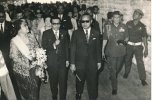
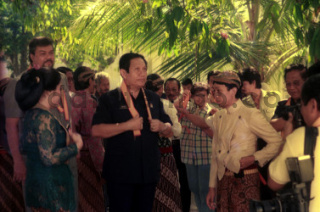
:strip_icc():format(jpeg)/kly-media-production/medias/2210010/original/021941300_1526044509-20180511-Anwar_Ibrahim.jpg)
